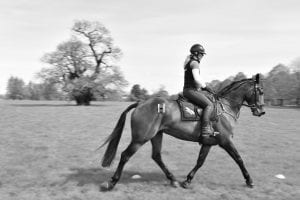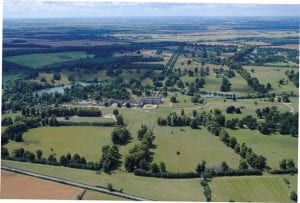Looking at old ground in a new way: in the field
By UCL ISH, on 5 July 2018

Work has continued on the ISH project ‘Looking at old ground in a new way’ into 2018, and in early May the team headed back to Burghley to undertake an exciting piece of work, this time with 5 horses and riders in tow. Having been at the mercy of an extended winter we were grateful that the sun was out in all its glory and the turf was in perfect condition. The work was being led by Russell Guire from Centaur Biomechanics and Dr Neil Linford from Historic England.
Prior to the horses arriving, Neil conducted a Ground Penetrating Radar (GPR) survey over known buried archaeological features. From a heritage perspective, the really interesting part of the fieldwork was seeing the horses each being fitted inertial measurement units (IMU). The IMU’s were fitted to measure the horses linear and angular motion over different ground conditions.
Both Neil and Russell agreed that the collection of their respective data through a heritage initiative was a first to their knowledge. By sharing their data, it’s hoped estate managers and the sport of eventing can make informed decisions on how best technologies and infrastructure can be integrated into historic landscapes. We look forward to seeing what comes of data collected and continuing this unique partnership.
Thank you also to the following for making the day a success:
David Purnell
Elizabeth Inman
Kathrine Bliss
Julia Dungworth
Victoria Bignell
Kelly Hetherington
Tamsyn Iveson
Tara Belcher
For more information contact Shaun McKinnar.
Shaun McKinnar
Research Assistant – Heritage science, Sport science & Wellbeing
UCL Institute for Sustainable Heritage
Senior Geophysicist at Historic England, Neil Linford’s blog for the project, Looking at old ground in a new way
By Daisy Voake, on 20 July 2017
Impact Report from Burghley

Russell’s presentation, together with the practical demonstration of the high speed camera system he uses in the field, was fascinating despite the heavy rain! As a geophysicist, I was particularly interested in the wireless instrumentation that can be applied for measuring 3-dimensional acceleration vectors, and how this can be combined with a range of other sensors to produce a full analysis of the data set. I could certainly imagine uses for this technology in areas of geophysical prospection where determining the accurate position and orientation of a sensor is required. We also had an interesting discussion regarding the interaction between buried archaeological remains and the impact this may have on equine performance – the sensitivity of a horse to objects at some depth was certainly of great interest.
Estates Director at Burghley, David Pennell’s blog for the project, Looking at old ground in a new way
By Daisy Voake, on 19 July 2017

We continue with May Cassar and Shaun McKinnar and the project team towards our next research goal in the autumn, which will also have seen the Land Rover Burghley Horse Trials 2017 take place.
David Pennell
Estates Director at Burghley
June 2017
Director of Centaur Biomechanics, Russell Guire’s blog for the project, Looking at old ground in a new way
By Daisy Voake, on 19 July 2017
Impact report from Burghley Workshop

From the biomechanics day two sciences; equine sports science and geophysics were discussed with a view of merging their application in a shared vison. A shared vision that would identify the impact that the surface could have on equine locomotion coupled with an evaluation of any potential damage caused to the underlying archaeology as a result of galloping horses on various x country routes. This vison was realised with both sciences showing excellent applications which could be used in a multidisciplinary approach in evaluating the key areas, effect that the surface has on locomotion and effect that locomotion could have on underlying archaeology. In particular; the terrestrial land system (TLS), is of interest in determining ground deformation and from the motion capture, identifying the impact that a deformed surface can have on the horse’s locomotor system. Equally, this deformation could lead to damage of underlying archelogy.
Other systems which could be of interest both in the project and with in equine sports science are ground scanning and thermal dynamic scanning. One of the key outcomes of the day was the shared vison and the willingness to push boundaries and seek collaborations with other sciences and sectors. With a proactive approach, I am confident that this shared vison will be fulfilled using some of the latest technology available. From an equestrian perspective this is of huge interest in helping to optimise the horse’s performance but more importantly helping to reduce the risk of injury.
Russell Guire
Director of Centaur Biomechanics
June 2017
Director of Policy and Campaigns at Historic Houses Association, Emma Robinson’s blog for the project, Looking at old ground in a new way
By Daisy Voake, on 19 July 2017
‘Horses and houses – exploring the synergies between historic houses and equestrian sport’

What do horses and ha-has have in common? Not much, you might think. But, as I discovered one very wet day in May, it turns out equestrian sport and historic house landscapes are inextricably intertwined.
The interrelationship of equestrian sport and the historic house estate is not new; from jousting in the Middle Ages, to modern equestrian sports such as carriage driving and eventing, beautiful historic house landscapes have long provided the setting for major horse sport events. What is perhaps surprising, and often overlooked, is the scale of this relationship in the 21st century – and the potential to develop the partnership between horse and house for mutual benefit.
Take Burghley House in Lincolnshire, for example, where on that damp day in May UCL ISH brought together a motley crew of heritage and equine business managers, a geophysicist, an archaeologist, an equine biomechanist and a policy wonk, to investigate the synergies between heritage and sport science. Horse trials have been held at Burghley since 1961, at the instigation of former owner the 6th Marquess of Exeter, an Olympic gold medallist in athletics. Today, Burghley’s Horse Trials are one of only six leading (e.g. 4*) three day events in the world – two of which are in Britain (the other being Badminton Horse Trials, which also takes place in the setting of a nationally important historic house). Burghley Horse Trials attracts around 165,000 spectators every year and induces spending in the local Lincolnshire economy estimated at £16.3 million, whilst generating some income for essential repairs, maintenance and conservation work at Burghley House.
It’s a similar story at other independent historic houses across the country, such as Blenheim Palace, Blair Castle and Gatcombe Park, which all run horse trials events. These popular events (over 17 million people are interested in equestrian sport, and over 4.5 million people ride regularly[1]) generate essential revenue for historic house estates, which helps to fund ongoing repair and maintenance work on the house, park and wider landscape. In turn, the magical surroundings of an historic house landscape provide a suitably dramatic backdrop for testing horse and rider to the limit.
And if equestrian sport is popular, heritage is even more so. There are over 61 million visits to historic properties each year[2], and 93 per cent of people think local heritage has an impact on their personal quality of life.[3] Nearly four times more people visited heritage attractions in 2016 than attended league and championship football matches[4]. Put two and two together, and it’s clear there is potential for equestrian sport and heritage attractions to collaborate to develop their economic, social and cultural offer.
On that May day at Burghley, the interdisciplinary team brought together by UCL ISH sought to explore that potential. Leading equine biomechanics expert Russell Guire delivered a session on using gait and rider analysis to evaluate a horse’s impact on surfaces, and Neil Linford, Senior Geophysicist at Historic England, discussed how heritage science could be used to improve the sustainability of historic landscapes used by equestrian sports. We hope this innovative study will identify the potential risks and mitigations to be addressed when integrating permanent equestrian sports surfaces into historic landscapes; and, ultimately, will enable the equestrian sector and the heritage sector to work together to develop and grow the success of horse trials events at historic house estates.
The potential impact on policy development at both a national and a local level is significant – from closer collaboration between government and agency teams responsible for developing the potential of the heritage and sports sectors, to better informed decision-making at a local level.
Ultimately, both historic house visitor attractions and equestrian sporting events are essential contributors to our economy and our society. Enabling them to develop their partnership for mutual benefit would be an important step forward in support of national heritage, sport and tourism policy priorities.
Emma Robinson
Director of Policy & Campaigns
Historic Houses Association
June 2017
[1] https://www.britisheventing.com/library-media/documents/Under_18_Open_Novice_lr.pdf
[2] https://content.historicengland.org.uk/content/heritage-counts/pub/2016/heritage-indicators-2016.pdf
[3] https://content.historicengland.org.uk/content/heritage-counts/pub/2016/heritage-and-society-2016.pdf
[4] https://content.historicengland.org.uk/content/heritage-counts/pub/2016/heritage-indicators-2016.pdf
 Close
Close


